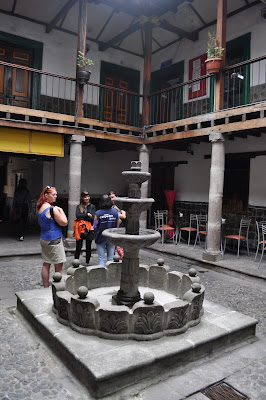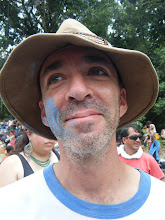
Quito is a large enough city that there is pretty much everything here that you could find in other places to stay busy for a while. There are shopping malls, markets, movies, theaters, parks, casinos, nightclubs and many restaurants for all budgets. All have somewhat of an Ecuadorian feeling, but nothing so unique that stands out from other places in South America or the world. Blame it on globalization.
So for this post I will focus on touristy places that seem unique to Quito and Ecuador which is mostly museums and the historic center. Everything in Quito is pretty much accessible by public transportation + short walks. Buses have their own lanes on the main thoroughfares which lets them whiz by traffic. Just watch out for pickpockets! Many other travelers take taxis around town, but I have managed to get everywhere by bus which costs only $0.25 per ride.
 |
| At the Plaza Grande in the historic center |
If there is anything in Quito that should be done it is to have a walk around the historic center. It is fun to walk around a living, breathing, pulsating city that happens to be almost five hundred years old. As in most colonial towns the buildings are painted in a bouquet of pastel colors. The persistent traffic, narrow sidewalks and modern shops never fully lets one escape to another time, but nevertheless, it is still impressive to be this close to history while ducking into ancient buildings to see their inner courtyards and architecture.
Like all old colonial towns, Quito has a huge number of churches. They were the center of life and the Spanish made a lot of effort to make them ostentatious, so the least we can do centuries later is to admire them from afar and near.
The Monastery of San Francisco is Quito's oldest and largest church. Construction started in 1504 and finished seventy years later. The plaza in front of the church is a lovely place to sit and people watch. If in the shopping mood, indigenous ladies walk around selling scarves at very reasonable prices.
La Compania de Jesus has seven tons of gold decorating the inside of its walls. Construction began in 1605 and only took 163 years to complete. It costs $3 to enter (gringo price) and no photos are allowed inside.
 |
| The gold-plated entrance way |
The Basilica del Voto Nacional sits on the edge of the historic center, but it is not old. Construction was started in the late 1800's and completed in the 1980's. There are much nicer churches to visit, but none of the others lets you climb up to the top of the belfries for a grand, if not queasy-inducing, view of Quito. It costs $2 to climb up and you can take as much time as you like. It is not for those with even a mild sense of acrophobia.
 |
| Basilica del Voto Nacional |
 |
| View from the top |
 |
| Inside the clock tower |
Quito is also the center for Ecuadorian politics. The presidential palace ( Ecuadorian White House, if you will) sits on the Plaza Grande in the heart of the historic center. They offer free tours several times a day. We get to see the cabinet meeting room and the banquet hall for official state dinners. The president of Korea will be arriving in a couple days.
 |
| Outside of the presidential palace |
 |
| Inside the pres. palace at the meeting room of the cabinet ministers |
For most travelers a trip to Quito also includes a visit to Mitad del Mundo - The Middle of the World. Ecuador actually means "equator" in Spanish and our planet's center line sits about 22 KM from Quito. A bus from the city will take you directly to the Mitad del Mundo park which has a monument dedicated to the invisible line running around the center of Mother Earth. However, we did not enter this park because the equator line is actually not there. And most other travelers tell us that the Mitad del Mundo park is boring anyway.
 |
| Jumping from Northern to Southern hemisphere |
In the 1700's some French dude got the exact location of the equator wrong. So the official equator monument is not at the actual equator. If you want to be at the real line you need to go to the Museo Inti Ñan which is a short walk from the bus stop. This museum has many signs boasting that they are at the real equator line and that they even used a military grade GPS to verify it. I would call this latitude with attitude.
 |
| In school they never taught us that the equator is an actual red line running around the world |
The museum is actually quite fun. The entrance is $3 and it includes a guided tour in English or Spanish. They first show us some exhibits describing traditional indigenous life in the Andes and Amazon jungle including a real shrunken head.
 |
| A real shrunken head |
Then we get to the goods. At exactly the equator our guide gives us some scientific demonstrations* to explain the forces at work at the middle of the earth such as Coriolis Effect (why water spins down a drain). For example, they say because the earth's forces are coming directly straight down a person should be able to balance an egg on a nail head. Everyone gets a chance to try it, and those successful earn a special certificate from the equator museum.
 |
The equator is egg-cellent |
* After doing some internet research it seems that these experiments are bunk and have nothing to do with being at the equator. I am not quite sure what to believe, but regardless it is still enjoyable at the museum. If tourists at the equator are fish, we'd be biting.
Follow
the link to see more things to do in Quito.
 Quito is a large enough city that there is pretty much everything here that you could find in other places to stay busy for a while. There are shopping malls, markets, movies, theaters, parks, casinos, nightclubs and many restaurants for all budgets. All have somewhat of an Ecuadorian feeling, but nothing so unique that stands out from other places in South America or the world. Blame it on globalization.
Quito is a large enough city that there is pretty much everything here that you could find in other places to stay busy for a while. There are shopping malls, markets, movies, theaters, parks, casinos, nightclubs and many restaurants for all budgets. All have somewhat of an Ecuadorian feeling, but nothing so unique that stands out from other places in South America or the world. Blame it on globalization. 





























No comments:
Post a Comment